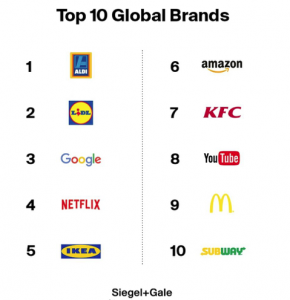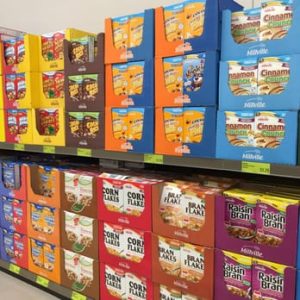I’m a big believer in the power of simplicity in our ever-busier world. Simplifying peoples’ lives can be a real source of competitive advantage, as shown by Siegel+Gale’s latest Global Brand Simplicity Index (an online survey of 14,000 respondents across nine countries):
- Premium pricing: simpler doesn’t have to mean cheaper – 64% of consumers are willing to pay more for simpler experiences.
- Word of mouth: saving time and hassle today is a real benefit, and one people talk about – 61% of consumers are more likely to recommend a brand because it’s simple.
- Business strength: A stock portfolio of the simplest global brands outperforms the major indexes by 330%.
Below I suggest some practical ways to simplify life, illustrated with examples of brands from the survey.

1. Simplify your range like Aldi
Aldi tops the global simplicity league table. Their rapid growth reflects in part their lower prices versus the big supermarket chains, but also the way they have simplified the shopping experience. They carry less brands and products per category, which makes it easier and quicker for people to choose what to buy, saving time in peoples’ busy lives. No worrying about which type of Kellogg’s Cornflakes to buy: Aldi only stock the best selling ‘original’ type (see below). Range simplification has also been part of Tesco’s turnaround, as I posted on here. A “range reset” moved Tesco to a simpler, more relevant range”, with a 23% reduction in range size. This in turn helped increase availability, another way of simplifying shopping.
Take a long, hard look at your range offering. Is every product/service adding value for consumers and making you money, or is there an opportunity to simplify?


2. Reduce ‘friction’ like Amazon
Amazon (6th in the league table) are the grand masters at taking friction (time and hassle) out of the purchase process. ‘One Click’ ordering is a huge time saver. In addition, the brand has continued to make delivery faster, another way to simplify life. First came Amazon Prime next day delivery. Even more impressive is Amazon Prime Now, which offers delivery of a shorter list of items in just one hour.
One industry ripe for a brand to take out friction in my book is the bloody hire car business, which accounts for three of the bottom 10 brands in the survey (Avis, Hertz and Budget). Why it still takes so long to pick up your car, despite having rented a car with the same company before, is beyond me.
Review the customer experience in your category. What are the opportunities to take friction out of the process of choosing and buying?
3. Be my personal assistant, like Netflix
Netflix is 4th in the table, helped by the way it acts as your personal entertainment assistant. First, it recommends shows you might like. But perhaps more important is the way it shows you a preview of the next episode of the series you’re watching, and plays it automatically for you. It even skips the re-cap and takes you right to the start of the action. The only caveat here is that one of the reasons some of us are so busy is that we are binging on Netflix box sets!
How can you act like a personal assistant in your category to do some of the work for the people who buy your product or service?
4. Be consistent, like McDonald’s
McDonald’s is 9th in the simplicity league table. Although the menu has become a lot more complex over time, the brand has stuck to and refreshed its core classic offerings including the Big Mac and the Happy Meal. In a busy world, with myriad food choices, sometimes people want the familiarity and simplicity of something they know will deliver satisfaction. Importantly, the brand is refreshing these core products to keep them relevant, such as the recent announcement to swap Minute Maid for Honest juice in the Happy Meal, cutting sugar content by half.
Are you dedicating time, talent and money to your core products and services, refreshing them to keep them relevant?
In conclusion, simplicity can be a powerful source of advantage in a busier and more complex world. When it comes to branding, less can indeed be more.